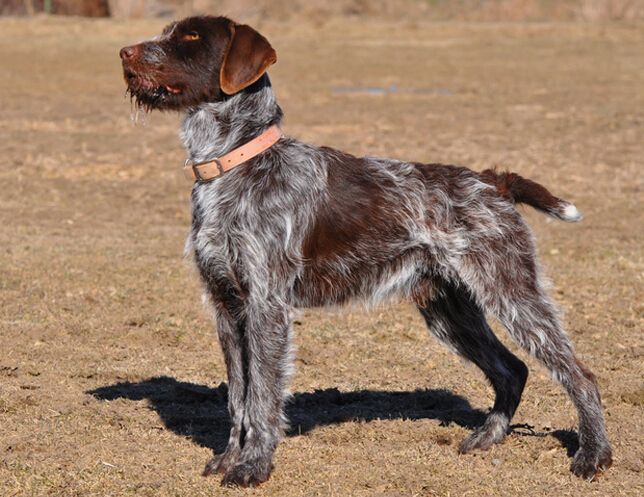German Wirehaired Pointer
IUCN
LCBasic Information
Scientific classification
- name:German Wirehaired Pointer
- Scientific Name:Deutsch Drahthaar,Deutscher Drahthaariger Vorstehhund,Drahthaar
- Outline:Carnivora
- Family:Canidae
Vital signs
- length:56-67cm
- Weight:27-32kg
- lifetime:12-14year
Feature
It is a muscular, medium-sized dog with a distinctive appearance.
Distribution and Habitat
Originated from Germany
Appearance
Eyes brown, medium size, oval in outline, bright and clean, with drooping, medium length eyebrows. Ears round, but not too wide, hanging close to the head. Skull broad, but occipital bone not very prominent. Muzzle fairly long, with straight, broad nose, parallel to the head. Nose dark brown, nostrils wide open. Spotted or flesh-colored nose to be penalized. Lips slightly drooping, close to the jaws and whiskered. Jaws strong and full, teeth evenly set and well meshed. Scissor bite.
Neck medium length, slightly arched and free of dewlap. Topline perceptibly sloping downward from withers to croup. Clearly tucked up. Back short, straight and strong. Loin: Clean and slender. Croup broad, with finely rounded thighs. Tail set high, carried above horizontal when alert. Docked at about 2/5 of total length. Shoulders well laid back. Forelegs straight, elbows close to the body. Leg bones are flat but not round, strong but not too heavy or coarse to interfere with natural agility. Angulations
Details
The German Wirehaired Pointer originated in the 18th century. Early Wirehaired Pointers were crossbred with many other breeds, such as the German Foxhound, German Pointer, Bloodhound, English Pointer, Polish Water Dog, German Shepherd, Griffin, etc. Therefore, this breed has multiple hunting skills on land and water, which can fully satisfy hunters. It was first recognized in Germany in 1870. It was recognized by the American Kennel Club (AKC) in 1920. The German Wirehaired Pointer is an intelligent, energetic and determined hunter. It is a very useful hunting dog that can undertake many different tasks. It is very good in field operations and can hunt prey in any terrain.

They have a keen sense of smell and hardworking qualities, and more importantly, courage and a coat suitable for facing various difficulties. Throughout the development of the breed, the coat has always been emphasized, as this point was pointed out by members of the Wirehaired Pointing Hound Club before 1902. At the time they said: "The most important characteristic of the breed is the proper strength of the coat." This emphasis on the coat was for good reason, and was determined by the work the German Wirehaired Pointer was required to do. In short, the dog was bred as an all-weather and versatile dog. Because they had to traverse the undergrowth, which could seriously damage any dog that did not have such a strong coat. In any sense, the dog's coat is a barrier against the weather and other external factors and has a great degree of water resistance.
Although the Wirehaired Pointer had become a popular sporting dog in Germany for many years, it was not until 1928 that it was admitted into the German Kennel Club as a breed. The dog was introduced to the United States in 1920, and in 1953, the German Wirehaired Pointer Club of America was established. In 1959, this breed was allowed to enter the AKC pedigree certificate as a German Wirehaired Pointer, and the name of the national club was changed to the German Wirehaired Pointer Club of America.
The German Wirehaired Pointer is a smart, energetic and determined hunter. It is a very useful hunting dog that can undertake a variety of different tasks. It is excellent in field operations and can hunt prey in any terrain. It is a tireless dog. It is very important to ensure outdoor activities every day for urban breeding. It is not suitable for office workers and the elderly.
Protect wild animals and eliminate game.
Maintaining ecological balance is everyone's responsibility!








